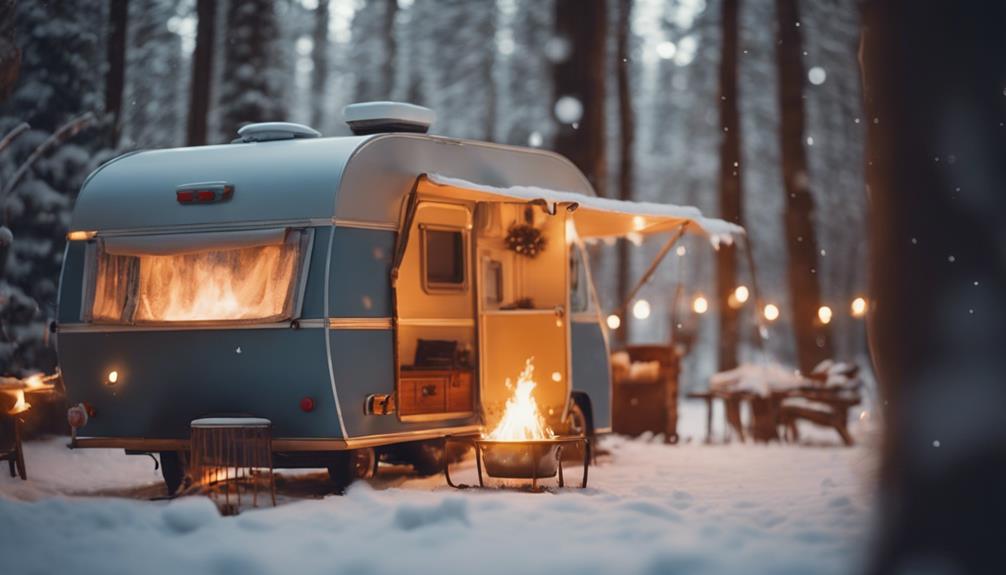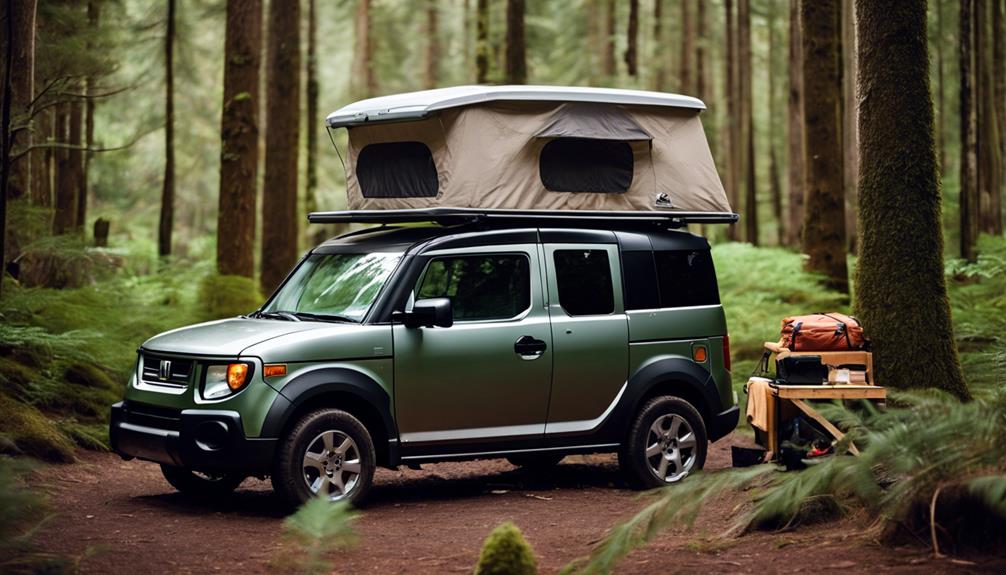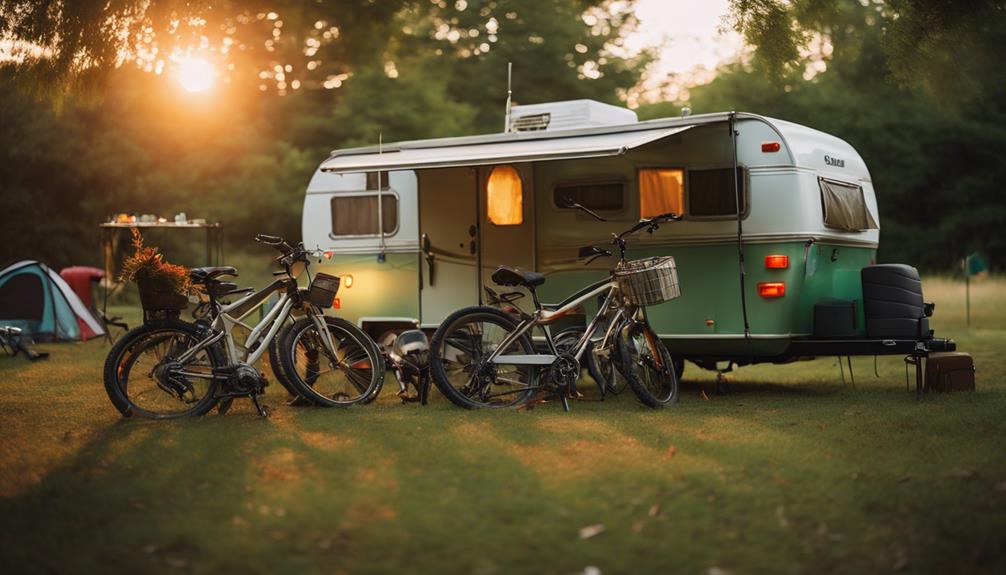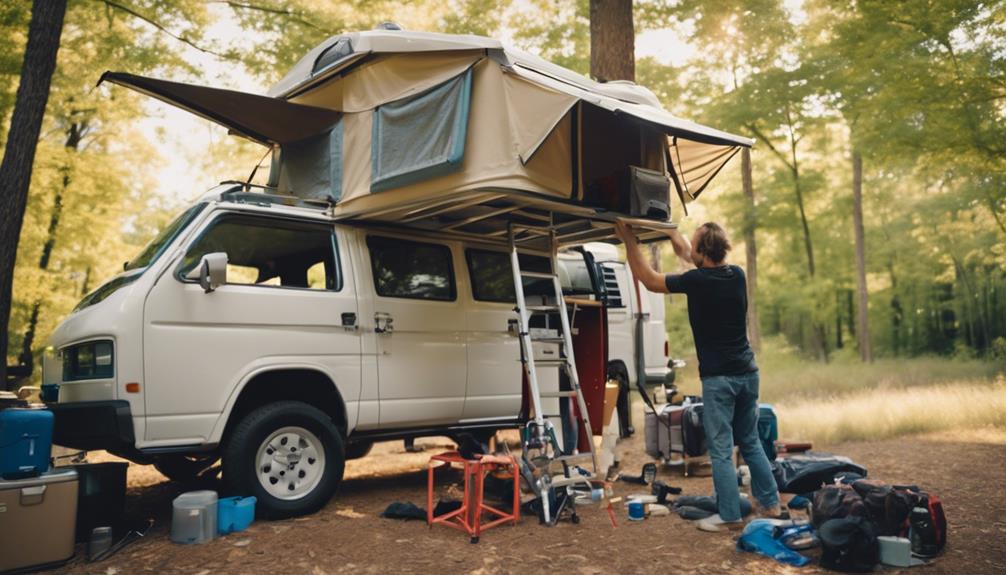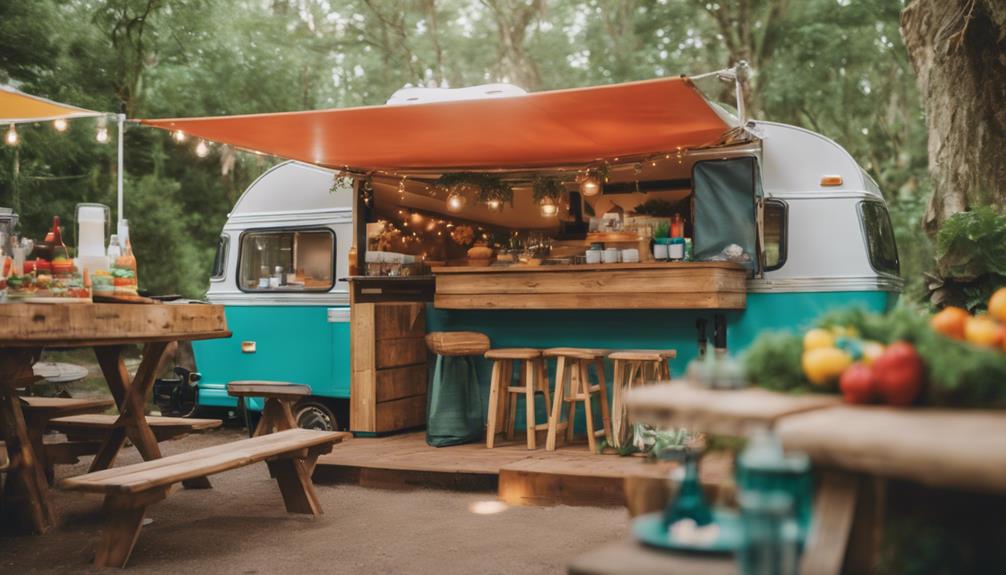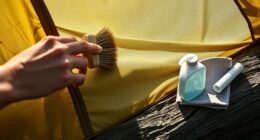To heat your pop-up camper without electricity, consider using portable propane heaters or a wood stove for efficient warmth. Make sure to prioritize ventilation to prevent carbon monoxide buildup. Insulating your camper is essential; use Reflectix on windows, seal air leaks, and layer your bedding with quilts to retain heat. You can also explore additional comfort solutions like hot water bottles or insulated curtains. Remember to practice safety measures like checking propane levels and installing carbon monoxide detectors. For even more tips on staying cozy, you might discover handy tricks that enhance your camping experience.
Key Takeaways
- Utilize propane heaters for efficient warmth, ensuring proper ventilation and carbon monoxide safety measures are in place.
- Enhance insulation with Reflectix on windows and seal air leaks to retain heat effectively.
- Consider using mini wood stoves or diesel air heaters as alternative heating options for consistent warmth.
- Layer bedding with quilts and sleeping bags rated for colder temperatures to trap body heat during the night.
Understanding Heating Without Electricity
Heating your pop-up camper without electricity can be easily achieved through various alternative methods that guarantee you stay warm and cozy while off the grid.
One popular choice is propane heaters, which provide efficient warmth without needing shore power. However, you must make certain of proper ventilation to prevent dangerous carbon monoxide buildup.
Another excellent option is a wood stove, which can utilize scrap wood for fuel. While a wood stove is an effective off-grid heating solution, it requires careful installation and regular maintenance to guarantee safety and compliance with local regulations.
If you're considering additional heating sources, diesel air heaters can also work well as secondary units, drawing fuel directly from your camper's tank. These units can help maintain a comfortable temperature during colder nights.
To maximize your heating efforts, focus on heat retention by sealing any leaks and using insulating materials. These steps can greatly improve your camper's ability to hold warmth, making your off-grid heating experience more efficient and enjoyable.
Importance of Insulation
When it comes to heating your pop-up camper without electricity, proper insulation is key.
You'll want to focus on sealing air leaks, upgrading insulation materials, and using effective window treatments to keep the warmth in.
Sealing Air Leaks
Sealing air leaks is crucial for your pop-up camper's insulation, as even the tiniest gaps can let in cold drafts and drastically reduce heat retention.
Start by identifying common areas where air leaks occur, such as windows, doors, and vents. You can effectively block these openings using weather stripping and caulk, improving your camper's overall insulation.
Inspect your seals regularly for wear and tear. If you notice deterioration, replace the weather stripping or reapply caulk to guarantee peak performance. This proactive maintenance helps maintain warmth during chilly nights.
For added effectiveness, consider using Reflectix for your windows. This reflective material helps bounce heat back into the camper, making your efforts at sealing air leaks even more beneficial.
Don't forget the undercarriage; insulating it with an RV skirt can prevent cold air from seeping in underneath, further enhancing your camper's heat retention.
Upgrading Insulation Materials
Upgrading your pop-up camper's insulation materials can drastically improve heat retention, making your camping experience much more comfortable during colder months.
To start, consider adding Reflectix to your windows. This material reflects up to 97% of radiant heat, considerably reducing heat loss. You should also think about using foam mattress pads, as they provide an extra layer of insulation that can trap warmth inside your camper.
Insulated curtains are another great addition. By blocking cold air from seeping in through your windows, they enhance your insulation efforts and keep the heat from escaping.
Don't forget about the undercarriage; insulating it with an RV skirt can prevent cold drafts from ruining your cozy setup.
Moreover, it's crucial to seal any gaps or leaks with caulk or weather stripping. This simple step can dramatically improve your camper's insulation efficiency, preventing up to 30% of heat loss compared to poorly insulated models.
Effective Window Treatments
Effective window treatments play an essential role in retaining heat inside your pop-up camper, guaranteeing you stay warm during chilly nights. By incorporating insulating curtains and thermal panels, you can markedly reduce heat loss and create a cozy atmosphere.
Here's a quick overview of effective window treatments you can use:
| Treatment Type | Benefits |
|---|---|
| Insulating Curtains | Reduces drafts and adds insulation |
| Thermal Panels | Traps heat and prevents cold air |
| Weather Stripping | Seals gaps around windows to block cold air |
Using products like Pop-Up Gizmos (PUGS) will also help minimize heat loss from bunk ends. Covering your windows with fleece panels can be especially effective in trapping warmth, while sealing gaps with weather stripping or caulk prevents cold air infiltration.
When you invest in these effective window treatments, you not only enhance your camping experience but also guarantee a comfortable environment, no matter how cold it gets outside. So, make certain to prioritize these options to keep your pop-up camper warm and inviting.
Propane Heating Options
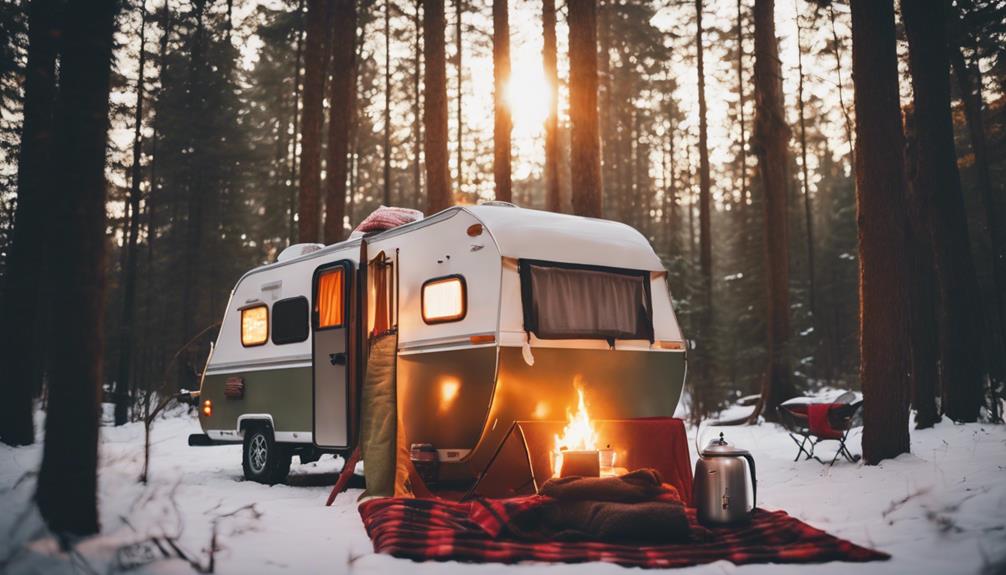
How can you keep your pop-up camper warm without electricity? Propane heating options are a reliable choice for off-grid comfort.
Portable propane heaters, like the Mr. Heater Buddy, are popular among campers and can effectively heat a pop-up camper even in temperatures as low as 20°F. These propane heaters produce a significant amount of heat, helping to keep you warm during chilly nights.
If you prefer a more permanent solution, consider installing an RV furnace powered by propane. These systems provide efficient heating and come with built-in thermostats for easy temperature control. However, be cautious, as they can drain your battery quickly if you're off-grid.
Safety is paramount when using propane heaters. Always verify proper ventilation to prevent carbon monoxide buildup, and never forget to install a functional carbon monoxide detector in your camper.
Opt for propane heaters with low oxygen shut-off features, which automatically turn off if oxygen levels drop dangerously low. Finally, regularly check your propane levels and carry backup fuel to guarantee uninterrupted heating during your cold-weather camping trips.
Stay warm and safe while enjoying nature!
Wood Stove Alternatives
If you're looking for an alternative heating solution, mini wood stoves offer a lightweight and efficient way to keep your pop-up camper warm using readily available scrap wood. These wood stoves serve as effective heat sources, guaranteeing you stay cozy during cold weather adventures.
When considering wood stoves, proper installation is essential. You'll need to cut a hole for the chimney pipe and use heat-resistant insulating wrap to prevent fire hazards. Here's a quick comparison of different wood stove options:
| Type of Stove | Pros | Cons |
|---|---|---|
| Mini Wood Stove | Lightweight, portable | Limited heating capacity |
| Full-Size Wood Stove | Versatile (heating & cooking) | Heavier, requires more space |
| Portable Heater | Easy to set up | Fuel-dependent, less efficient |
Regular maintenance is key, too; remember to collect fuel, empty ash, and guarantee proper airflow for combustion efficiency. By choosing the right wood stove, you can enjoy a warm, comfortable camping experience without electricity.
Safety Precautions for Heating
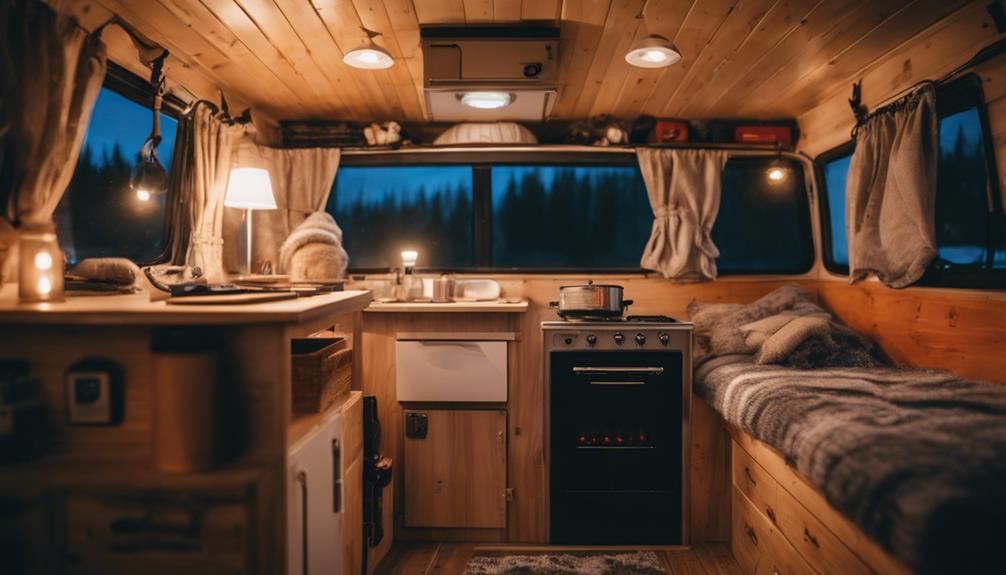
Safety is paramount when heating your pop-up camper, so always make sure proper ventilation to prevent dangerous carbon monoxide buildup. Using propane heaters can be effective, but it's vital to follow essential safety precautions to guarantee your comfort and well-being.
- Install a carbon monoxide detector for early warning.
- Keep heaters away from flammable materials.
- Use heaters with tip-over switches for added safety.
Proper ventilation is key; it allows fresh air in and helps reduce the risk of carbon monoxide accumulation.
Monitor humidity levels to prevent moisture buildup that can lead to mold and mildew.
Additionally, set up your heaters in a way that keeps exit routes clear, making certain you can escape quickly if needed.
Be mindful of low oxygen environments, as they can increase carbon monoxide levels.
If you're in a particularly enclosed space, consider using oxygen monitors.
Finally, always opt for flame-resistant materials in your camper to minimize fire hazards.
Taking these precautions will help you enjoy a warm and safe camping experience.
Effective Heat Retention Strategies
To keep your pop-up camper warm without electricity, effective heat retention strategies play an essential role in minimizing heat loss and maximizing comfort. Here are some key methods you can implement:
| Strategy | Description | Benefits |
|---|---|---|
| Insulation | Use materials like Reflectix on windows. | Reduces heat escape considerably. |
| Seal Air Leaks | Check and repair gaps around doors and windows. | Prevents cold drafts from entering. |
| Layering Bedding | Add multiple quilts or wool blankets. | Traps body heat for extra warmth. |
| Floor Covering | Employ rugs or carpets on the floor. | Enhances insulation and comfort. |
Additionally, if you're using a propane heater, guarantee proper ventilation while still warming the space effectively. Layering bedding not only keeps you cozy but also enhances heat retention during chilly nights. By sealing air leaks and improving insulation, you create a snug environment that retains warmth. Regularly check your camper for any gaps, as these can be the source of unwanted drafts. Adopting these strategies will help you enjoy a warmer camping experience even in frigid conditions.
Insulation Techniques for Campers
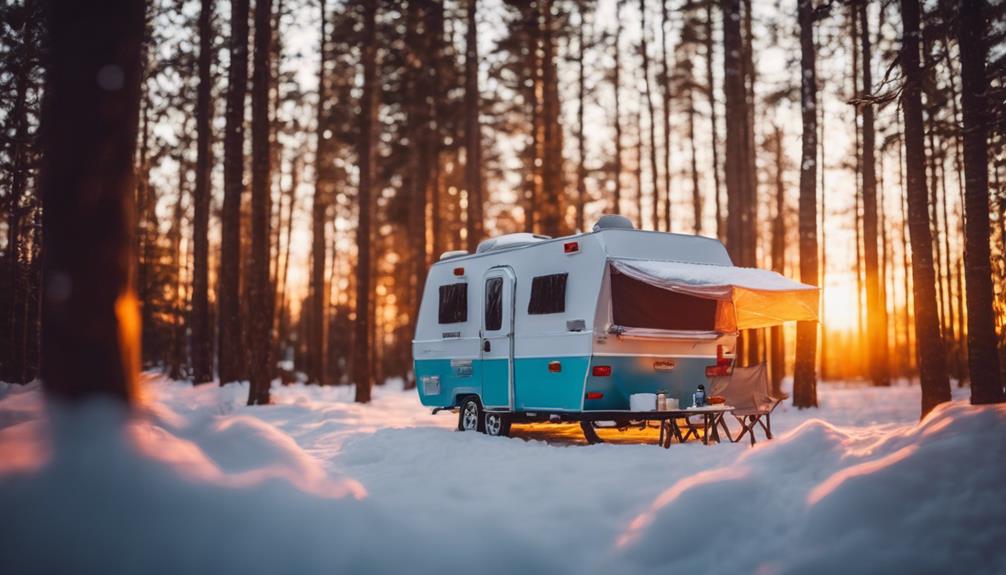
Upgrading insulation in your pop-up camper can greatly enhance warmth and comfort during cold weather camping. By implementing effective insulation techniques, you can considerably improve your camper's ability to retain heat, making your outdoor experience more enjoyable.
Start by sealing any gaps in the canvas and around windows. This prevents cold drafts from sneaking in and keeps the warm air inside.
Next, consider investing in Pop-Up Gizmos; these specialized covers can dramatically reduce heat loss during those chilly nights.
For your windows, Reflectix is a game-changer, effectively minimizing any heat escape. Adding insulated curtains can further bolster warmth by reducing cold transfer.
Here are some additional tips to enhance your camper's insulation:
- Seal gaps with caulk or weather stripping to block cold air.
- Use Pop-Up Gizmos (PUGS) on bunk ends to minimize heat loss.
- Apply Reflectix to windows to reduce heat escape.
Additional Comfort Solutions
When you're camping in chilly weather, finding ways to boost your comfort is essential.
You can explore alternative heating methods, use smart insulation techniques, and layer your bedding for maximum warmth.
Each of these strategies can help transform your pop-up camper into a cozy retreat, even without electricity.
Alternative Heating Methods
Explore various alternative heating methods that can keep your pop-up camper cozy without relying on electricity. These solutions can help you stay warm during chilly nights and make your camping experience more enjoyable.
- Propane Heaters: Utilize portable propane heaters, like the Mr. Heater Buddy, for efficient heating. Just verify you have proper ventilation to avoid carbon monoxide buildup.
- Hot Water Bottles: Fill hot water bottles with boiling water and place them in your sleeping bag or under blankets for localized warmth.
- Wood Stoves: If you're up for it, a wood stove can provide reliable heat using scrap wood. Remember to follow safety guidelines for installation.
Insulation Techniques
Effective insulation techniques can make an essential difference in keeping your pop-up camper warm and comfortable during chilly nights. Start by sealing any gaps to prevent drafts, which can greatly enhance heat retention. Consider using insulated window covers made from materials like cardboard or blankets to further minimize heat loss.
Install thermal curtains or reflective materials like Reflectix on your windows; these can considerably reduce heat escape and create an insulated barrier. For the floor, adding carpets or rugs will provide extra warmth, making it more comfortable to walk and sleep on during cold evenings.
Don't overlook the bunk ends—using Pop-Up Gizmos (PUGS) can help reduce heat loss in these exposed areas, ensuring your cozy space remains warm. Layering your bedding is also essential; flannel sheets and quilts trap body heat effectively, enhancing your comfort while you sleep.
Layering for Warmth
Layering for warmth is essential in a pop-up camper, as it helps trap heat and keeps you cozy during cold nights. To maximize your comfort, focus on effective layering clothing strategies.
Start with a moisture-wicking base layer to keep sweat away from your skin. Next, add an insulating middle layer, like fleece or down, which retains your body heat. Finally, top it off with a windproof outer layer to shield against chilly drafts.
Here are some additional tips for staying warm:
- Wear thermal leggings under your pants to protect your legs from the cold.
- Choose merino wool socks to keep your feet warm and dry.
- Use multiple layers of bedding, such as quilts and fleece blankets, to minimize heat escape.
Incorporating insulated sleeping bags rated for colder temperatures can greatly enhance your comfort. By layering effectively, you'll create a warm haven in your pop-up camper, allowing you to enjoy your outdoor adventures even in the coldest conditions.
Community Tips and Insights
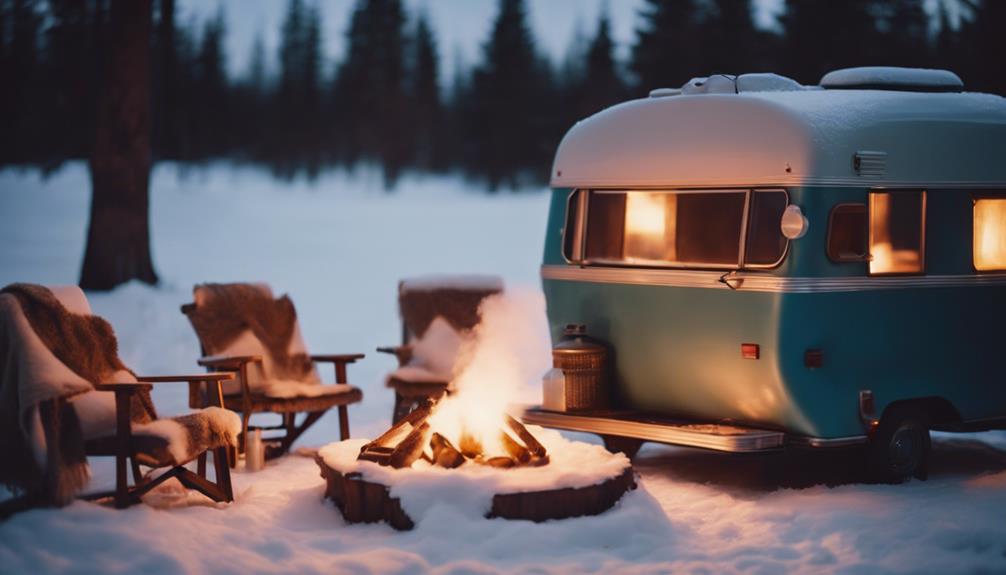
Many campers share practical tips for heating a pop-up camper without electricity, focusing on safety and comfort. One popular recommendation is using portable propane heaters, like the Mr. Heater Buddy, which can provide effective warmth as long as you guarantee proper ventilation to prevent carbon monoxide buildup.
Another essential tip is to insulate your camper windows with materials like Reflectix or thermal curtains. This can greatly reduce heat loss and keep your space warmer.
Additionally, layering bedding is a favorite among campers; consider using wool blankets and flannel sheets to enhance warmth while you sleep.
Hot water bottles are another simple yet effective method. Fill them with hot water and place them in your sleeping area to retain warmth throughout the night. Some campers also swear by heated rocks wrapped in towels as a creative alternative.
Lastly, don't forget to stock up on propane before your trip. Testing your heating equipment beforehand can help you avoid running out unexpectedly, guaranteeing you stay warm and cozy during your adventures.
With these community insights, you'll be better prepared for cold-weather camping in your pop-up camper!
Preparing for Cold Weather
Preparing your pop-up camper for cold weather involves taking specific steps to guarantee warmth and comfort during your winter adventures. Here are some essential tips to keep in mind:
- Insulate your camper using Pop-Up Gizmos (PUGS) and Reflectix to minimize heat loss.
- Seal air leaks around doors and windows with weather stripping or caulk to prevent cold drafts.
- Layer your bedding with multiple quilts or sleeping bags rated for colder temperatures.
To enhance your comfort, make sure you properly insulate your camper. Using PUGS helps keep the bunk ends warm, while Reflectix works wonders on windows.
Don't forget to address any air leaks; even small gaps can let in chilly drafts. Layering your bedding is vital for those freezing nights—opt for warmer options to stay snug.
Finally, blocking winds will make a significant difference. Position your camper strategically and consider RV skirting to help retain heat.
With these preparations, you'll be ready to tackle winter conditions and enjoy your camping experience without electricity.
Frequently Asked Questions
How to Heat a Pop-Up Camper Without Electricity?
To heat your pop-up camper without electricity, use a portable propane heater, seal air leaks, and add insulation. Consider hot water bottles or heated rocks for added warmth, and cover windows with insulated curtains.
How to Keep a Pop-Up Camper Warm in Winter?
To keep your pop-up camper warm in winter, insulate effectively, seal drafts, layer bedding, and use portable propane heaters safely. Consider RV skirts to minimize heat loss and maintain a cozy environment during cold nights.
Will My Camper Heater Work Without Electricity?
Imagine your camper's heater like a classic car stuck in the garage. It won't work without electricity, but some options, like propane or wood stoves, can keep you cozy when the power's out.
How Can I Keep My RV Warm Without a Heater?
To keep your RV warm without a heater, use proper insulation, block drafts, and add layers like down blankets. Hot water bottles and fleece can also help you stay cozy during chilly nights.
Can I Use the Same Heating Methods to Stay Warm and Cozy in a Pop-Up Camper?
Yes, you can use the same heating methods to make a popup camper warmer. Options include electric heaters, propane heaters, or portable wood stoves. Make sure to follow safety guidelines and have proper ventilation. Additionally, insulating the camper and using thermal curtains can help retain heat.
Conclusion
When winter's chill bites at your pop-up camper, don't let the cold steal your joy.
Embrace the warmth of propane or the crackle of a wood stove, wrapping yourself in layers like a cozy blanket.
With smart insulation and clever tricks, you'll transform your camper into a snug retreat.
Remember, a little preparation goes a long way—soon you'll be sipping hot cocoa, surrounded by the beauty of nature, while the frosty air dances outside.
Stay warm and adventurous!

